
Begonia is a genus of perennial flowering plants in the family Begoniaceae. The genus contains more than 2,000 different plant species. The Begonias are native to moist subtropical and tropical climates. Some species are commonly grown indoors as ornamental houseplants in cooler climates. In cooler climates some species are cultivated outside in summertime for their bright colorful flowers, which have sepals but no petals.

Iridescence is the phenomenon of certain surfaces that appear to gradually change colour as the angle of view or the angle of illumination changes. Iridescence is caused by wave interference of light in microstructures or thin films. Examples of iridescence include soap bubbles, feathers, butterfly wings and seashell nacre, and minerals such as opal. Pearlescence is a related effect where some or most of the reflected light is white. The term pearlescent is used to describe certain paint finishes, usually in the automotive industry, which actually produce iridescent effects.

Begoniaceae is a family of flowering plants with two genera and about 2040 species occurring in the subtropics and tropics of both the New World and Old World. All but one of the species are in the genus Begonia. There have been many recent discoveries of species in the genus Begonia, such as Begonia truncatifolia which is endemic to San Vincente, Palawan. B. truncatifolia is smaller in size than other species of the genus Begonia and this new species is proposed Critically Endangered by standards set by the IUCN. The only other genus in the family, Hillebrandia, is endemic to the Hawaiian Islands and has a single species. Phylogenetic work supports Hillebrandia as the sister taxon to the rest of the family. The genus Symbegonia was reduced to a section of Begonia in 2003, as molecular phylogenies had shown it to be derived from within that genus. Members of the genus Begonia are well-known and popular houseplants.

Begonia acerifolia is a species of plant in the family Begoniaceae. It is native to Ecuador, Peru and Bolivia. Its natural habitats are subtropical or tropical moist montane forests and subtropical or tropical dry shrubland. It is threatened by habitat loss.
Begonia hainanensis is a species of plant in the family Begoniaceae. It is endemic to China. It grows in forests and on mossy rocks.
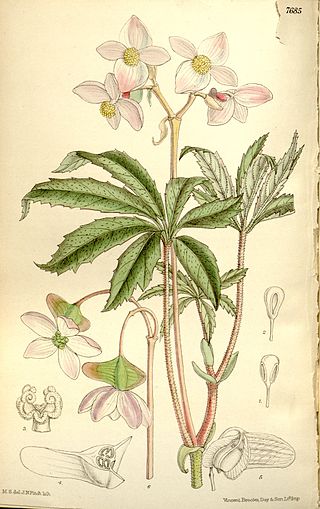
Begonia hemsleyana is a species of plant in the family Begoniaceae. It is a rhizomatous geophyte native to southwestern Guangxi and southeastern Yunnan in southern China, and to Laos, Myanmar, and Vietnam in northern Indochina.

Begonia coccinea, the scarlet begonia, is a species of plant in the family Begoniaceae. It is native to the Atlantic Forest of Brazil.
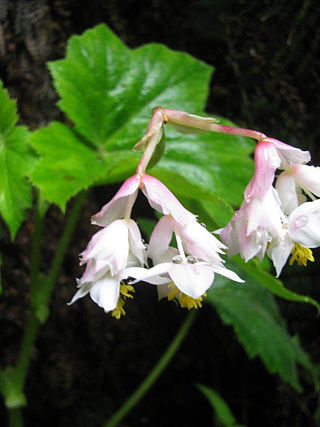
Hillebrandia sandwicensis is a species of a herbaceous perennial flowering plant native to some of the Hawaiian Islands. Common names include ʻakaʻakaʻawa and puʻa maka nui. The genus name honors the German physician William Hillebrand.
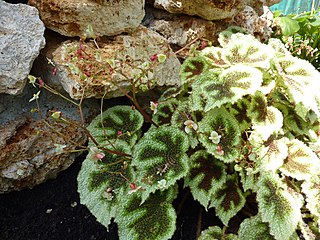
Begonia masoniana, the iron cross begonia, is a species of plant in the family Begoniaceae, native to southern China and northern Vietnam. It was originally described from cultivated plants of unknown origin and was only much later rediscovered in the wild.
Begonia thaipingensis is a species of is a species of plant in the family Begoniaceae.It is endemic to Malaysia.
The Philippine Taxonomic Initiative (PTI) is a private Philippine research institute and non-profit organization founded in 2018, located in the Philippines.
Begonia tonkinensis is a plant species in the family Begoniaceae. The species is part of the section Diploclinium. It was described in 1919 by François Gagnepain.
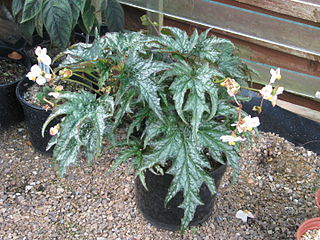
Begonia sikkimensis is a species of flowering plant in the family Begoniaceae, native to Tibet, Nepal, the eastern Himalayas, Assam, and Myanmar. With its highly dissected leaves it resembles Begonia U614, but that as yet undescribed species is rhizomatous, and Begonia sikkimensis is caulescent.
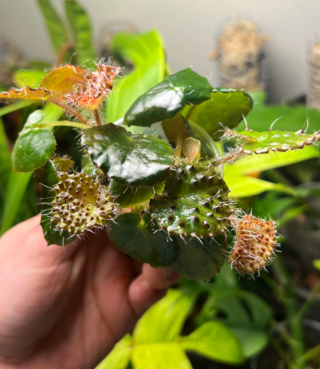
Begonia ferox is a species of flowering plant in the family Begoniaceae. Begonia ferox has been documented in Guangxi Zhuangzu growing on limestone outcroppings of the forest floor. It has a creeping growth habit, with leaves up to 19 cm long and 13 cm wide. When the leaves reach maturity, blackish-brown and hairy bullae with red tips emerge, up to 1.3 cm tall and .6 cm wide. It flowers from January through May, producing fruit April through July. Carpellate flowers are pinkish white, while staminate flowers are pinkish yellow, and the fruit is reddish-green.
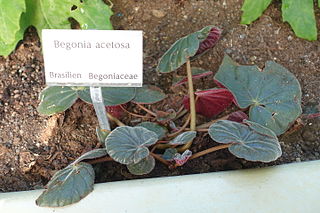
Begonia acetosa is a species of flowering plant in the family Begoniaceae, native to southeastern Brazil. It is used to create new begonia hybrids due to its attractive foliage. Begonia acetosa has been cultivated in the United States since 1946, when Mulford B. Foster introduced the species from forested mountains near Rio de Janeiro. It was first described in 1831 by José Mariano de Conceição Vellozo. The specific epithet acetosa means 'acid' or 'sour', referring to the rhubarb-like taste of its leaves.
Begonia amphioxus is a species of flowering plant in the family Begoniaceae, section Petermannia, native to Sabah state, Malaysia. There it is found growing in light shade on limestone, either at the base of cliffs or on top of outcrops. A shrub reaching 40 cm (16 in), its upright peltate leaves are 5 to 12 cm long, lance-shaped and pointed at both ends. The highly ornamental leaves are olive to mid-green, with red spots and a red border around the margin.

Begonia xanthina is a species of flowering plant in the family Begoniaceae, native to the eastern Himalayas, Assam, and southwestern Yunnan in China. A rhizomatous geophyte reaching 40 cm (16 in), it is typically found growing near streams on rocky forested hills up to 800 m (2,600 ft) in elevation. It resembles Begonia rex, but with yellow flowers and scattered light green splotches on the leaves.
Begonia fusca is a species of flowering plant in the family Begoniaceae, native to central and southern Mexico, Guatemala, and Honduras. A large rhizomatous species, its leaves can be 67 cm (26 in) long by 54 cm (21 in) wide, mounted on 80 cm (31 in) petioles.
Begonia baik is a species of flowering plant in the family Begoniaceae, native to Borneo. A creeping to sub-erect perennial with maroon to dark green rugose leaves, it is found growing at the base of sandstone cliffs or on earthy slopes.












